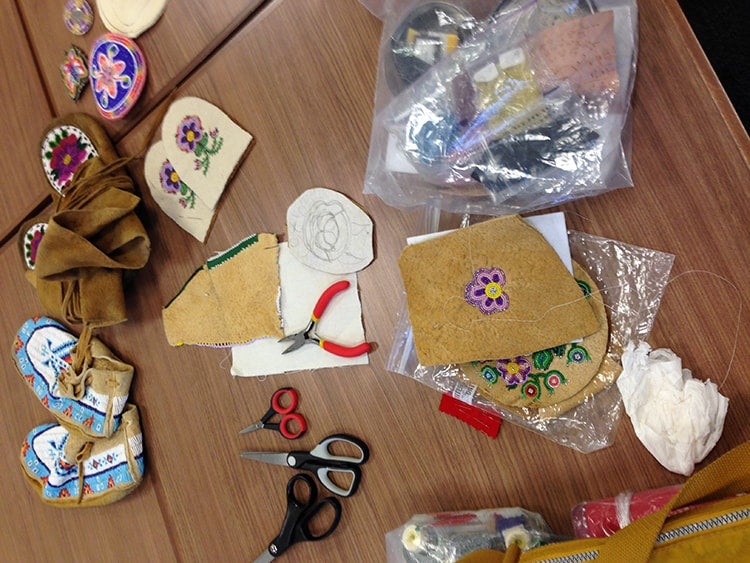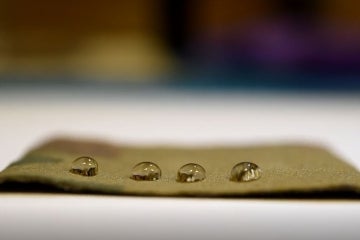First Indigenous faculty scholar at U of T's Jackman Humanities Institute connects community through beading

Published: January 26, 2017
Sherry Farrell Racette links past and present Indigenous culture through beading.
The Jackman Humanities Institute’s first Indigenous faculty scholar, Farrell Racette, is an associate professor of Native studies and women’s & gender studies at the University of Manitoba. She is at U of T for the 2016-17 academic year.
Farrell Racette researches Métis and First Nations women’s history. She has edited, written and illustrated books, and this year is preparing her doctoral dissertation for publication. But it is through beading that she connects with her roots and Indigenous women artists.
“Beadwork connects me and stitches me into a lineage of women artists that I strive to stand among,” she says. “There is a magic in beading – that doesn't always happen, but when you get a good rhythm going, it's meditative and therapeutic.”

Sherry Farrell Racette’s beading table at Jackman (photo courtesy of Sherry Farrell Racette)
She learned to bead in northern Manitoba from the late Kathleen Delaronde in The Pas and later from the late Margaret McCauley from Cumberland House in northern Saskatchewan.
“Beading is extremely time-consuming, especially with more ambitious pieces,” she says. “It cannot be rushed.
“You sit in one spot for hours. Your back gets sore and your shoulders get tense. My fingers sometimes cramp. It’s also very hard on the eyes.”
And then there's the needle cuts.
“When beading artist Jamie Okuma posted pictures of her hand – with every finger wrapped in a band aid – and the cuts and marks obvious, it opened things up for me,” says Farrell Racette. “I realized there was no easy place at that level. There was only working through discomfort, putting in the long hours and just getting it done.”
Over the years, she has bonded with others over beading.
“When Jamie Okuma and Charlene Holy Bear started posting pictures of their messy tables, spilled beads and their pitiful hands, it looked like my table, my mess, my hands,” says Farrell Racette. “I was greatly heartened by the fact that I struggled as they did – although my results are much more modest. Among a small group of artist friends, sharing our mishaps and struggles is a way to bead together.”
One powerful notion that she talks about is “beading for a greater purpose.” This idea is perhaps best represented by the artwork, Walking With Our Sisters, where Farrell Racette served as both an installation advisor and contributor.
Walking With Our Sisters consists of over 1,750 beaded moccasin vamps or uppers. These are intentionally not sewn into moccasins so each one represents the unfinished life of one murdered or missing Indigenous woman or girl. The vamps were created by over 1,000 volunteers, a large percentage of whom were first-time beaders.
“Just installing the vamps takes at least three days,” says Farrell Racette. “Physically hard work too, since you lay every pair on the floor. It is emotionally hard, as each pair represents a woman. You alternate between awe at the beautiful beadwork and tears at a child's ‘Miss You.’”
Farrell Racette says people’s response to seeing Walking With Our Sisters is what you would imagine: quiet, hushed, grief, but also hope.
“For people from outside the indigenous community – the extent of the loss is often overwhelming. The enormity of it,” she says. “For people from within, we are remembering our own losses. Walking through is not as hard as installing. Only the people who install the vamps know what is written on the backs. Reading the dedications, especially from children, is heartbreaking. These women were so loved, and are so missed.”
It is in this way that beadwork serves a greater purpose, says Farrell Racette.
“Every bead you sew when you are beading for a loved one stitches a thought, a wish,” she says. “It can also be playful, but that is also therapeutic. There are times when life feels beyond our control. Sometimes I think, well there's nothing I can do about that, but I can manage this little row of beads. I can create something beautiful out of difficulty and pain.”
Farrell Racette says her collective beading will focus on the communities she’ll be part of while she’s in Toronto. She has already beaded with both the Indigenous arts program from OCAD University and the Indigenous literature research group from the Jackman Humanities Institute at the Faculty of Arts & Science.
“I’ll do another with any interested Jackman fellows,” she says. “I will also be beading with a small group at Massey College where I am a visiting resident scholar.”



